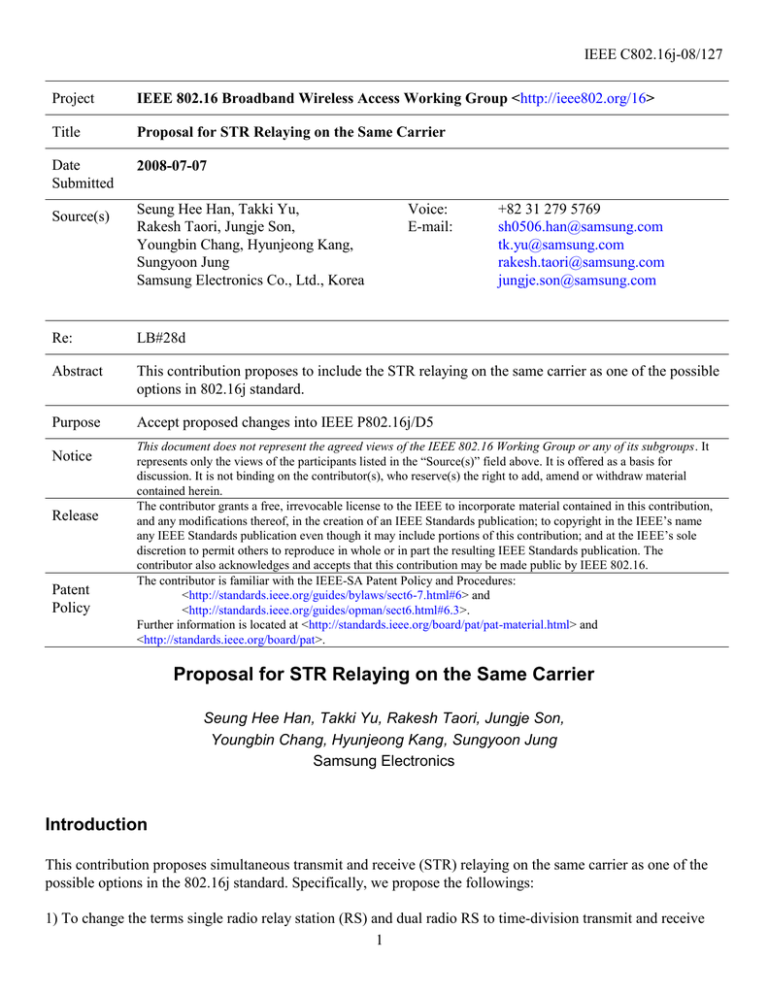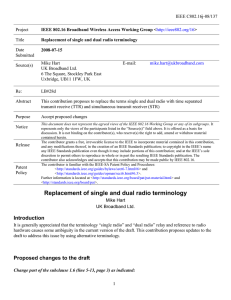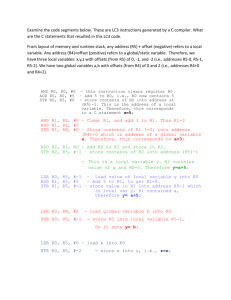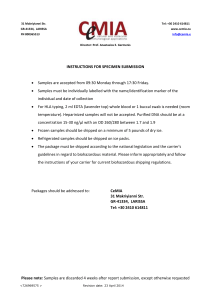IEEE C802.16j-08/127 Project Title
advertisement

IEEE C802.16j-08/127 Project IEEE 802.16 Broadband Wireless Access Working Group <http://ieee802.org/16> Title Proposal for STR Relaying on the Same Carrier Date Submitted 2008-07-07 Source(s) Seung Hee Han, Takki Yu, Rakesh Taori, Jungje Son, Youngbin Chang, Hyunjeong Kang, Sungyoon Jung Samsung Electronics Co., Ltd., Korea Re: LB#28d Abstract This contribution proposes to include the STR relaying on the same carrier as one of the possible options in 802.16j standard. Purpose Accept proposed changes into IEEE P802.16j/D5 Notice Release Patent Policy Voice: E-mail: +82 31 279 5769 sh0506.han@samsung.com tk.yu@samsung.com rakesh.taori@samsung.com jungje.son@samsung.com This document does not represent the agreed views of the IEEE 802.16 Working Group or any of its subgroups. It represents only the views of the participants listed in the “Source(s)” field above. It is offered as a basis for discussion. It is not binding on the contributor(s), who reserve(s) the right to add, amend or withdraw material contained herein. The contributor grants a free, irrevocable license to the IEEE to incorporate material contained in this contribution, and any modifications thereof, in the creation of an IEEE Standards publication; to copyright in the IEEE’s name any IEEE Standards publication even though it may include portions of this contribution; and at the IEEE’s sole discretion to permit others to reproduce in whole or in part the resulting IEEE Standards publication. The contributor also acknowledges and accepts that this contribution may be made public by IEEE 802.16. The contributor is familiar with the IEEE-SA Patent Policy and Procedures: <http://standards.ieee.org/guides/bylaws/sect6-7.html#6> and <http://standards.ieee.org/guides/opman/sect6.html#6.3>. Further information is located at <http://standards.ieee.org/board/pat/pat-material.html> and <http://standards.ieee.org/board/pat>. Proposal for STR Relaying on the Same Carrier Seung Hee Han, Takki Yu, Rakesh Taori, Jungje Son, Youngbin Chang, Hyunjeong Kang, Sungyoon Jung Samsung Electronics Introduction This contribution proposes simultaneous transmit and receive (STR) relaying on the same carrier as one of the possible options in the 802.16j standard. Specifically, we propose the followings: 1) To change the terms single radio relay station (RS) and dual radio RS to time-division transmit and receive 1 IEEE C802.16j-08/127 (TTR) RS and STR RS, and to change text related to these modifications. 2) To include clear definition of TTR relaying, TTR RS, STR relaying, and STR RS. 3) To change the text that blocks the STR RS to communicate with the superordinate station and subordinate station(s) simultaneously using the same carrier. STR relay station and TTR relay station In the current standard draft (IEEE P802.16j/D5), the terms “single radio relay station” and “dual radio relay station” are described as follows: • A single radio relay station can either perform relaying on the same carrier frequency or on a separate carrier frequency, depending on its negotiated and configured capability, by time dividing communication with the superordinate station and subordinate station(s). (line 39-41, page 204) • A dual radio relay station supports simultaneous communication with subordinate station(s) and the superordinate station by using different radio hardware to communicate with the subordinate stations from that used to communicate with the superordinate station. (line 35-38, page 205) The above definitions mention the number of hardwares in relay stations which seems to be not appropriate for standard. In addition, the definition of “radio hardware” is not clear at all. Better terms that can capture the features of these relay stations would be “time-switched transmit and receive (TTR) relay station” and “simultaneous transmit and receiver (STR) relay station”. Specifically, we propose to include the following definitions in Section 3 to define these clearly: • Time-division transmit and receive (TTR) relaying : a relaying mechanism where communication with the superordinate station and subordinate station(s) is separated in time. • TTR RS : a non-transparent relay station which performs TTR relaying. • Simultaneous transmit and receive (STR) relaying : a relaying mechanism where communications with the superordinate station and subordinate station(s) are performed simultaneously. • STR RS: a non-transparent relay station capable of performing STR relaying. We also propose to change the text that has the term “single radio” or “dual radio” throughout the standard according to above modifications. Capabilities of TTR RS and STR RS In the current standard draft, single radio RS (TTR RS with new definition) is capable of relaying on the same carrier frequency or on a separate carrier frequency by time dividing communication with the superordinate station and subordinate station(s). Dual radio RS (STR RS with new definition) supports simultaneous 2 IEEE C802.16j-08/127 communication with superordinate station and subordinate station(s). Currently, the transmission and reception of the STR RS is restricted to be performed on separate carriers. However, it is not necessary to limit the operation of STR RS on two separate carriers because of the following reasons: 1) STR relaying can be readily performed on the same carrier in some of the usage models of 802.16j as shown in Figure 1. In the usage models such as underground and coverage hole where sufficient level of isolation between relay transmit and receive antennas is likely to be present, we can exploit the benefits of STR relaying on the same carrier. For the case when some operators want to operate the STR relaying on the same carrier in those usage models, we do not need to block this operation. RS Multihop Relay Coverage hole Penetration into inside room Mobile Access RS Shadow of buildings RS Coverage extension to isolated area RS BS RS Valley between buildings RS Coverage extension at cell edge Possible usage models of STR relaying on the same carrier Underground Figure 1. Usage model of STR relaying on the same carrier 2) As explained below, the STR RS have advantages when it communicates with superordinate station and subordinate station(s) on the same carrier. • • • Potential increase in spectral efficiency : re-utilizes BS-RS link resources as RS-MS link resources Reduced overhead : no need for R-TTG and R-RTG, relay amble, and duplicated broadcasting information No loss in uplink coverage : an MS can send data over the whole UL frame to increase uplink coverage 3) Allowing STR RS operation on the same carrier is not accompanied by significant changes in the current standard draft. Just relaxing the limitations which restrict the STR relaying to be performed on a different carrier would be sufficient. It does not require any new management message, new field in existing messages, and so on. 3 IEEE C802.16j-08/127 STR RS frame structure The frame structure of STR RS is shown in Figure 2. The first and second carrier can be the same or can be different in STR RS. Network entry – Capability negotiation An RS capable of STR relaying can inform the MR-BS during network entry using SBC negotiation. Current MR PHY features supported by the RS and MR-BS include “support of dual radio RS operation” as shown in subclause 11.8.3.7.22. By just changing it to “support of STR RS operation” and relaxing the constraints in the bit setting, STR RS operation can be supported. We also would like to clarify the meaning of the bit settings as shown in the proposed changes. RS_Config-CMD message The field in subclause 11.25.1 may be used by an MR-BS to configure one or a group of RSs. One bit in the “RS operational mode” indicates “operate in dual radio mode”. We can change it to “operate in STR relaying mode”. We also would like to clarify the meaning of the bit settings as shown in the proposed changes. Reference: [1] IEEE P802.16j/D5, June 2008 4 IEEE C802.16j-08/127 Figure 2. An example of frame structure for STR RS. 5 IEEE C802.16j-08/127 Proposed changes to the draft Change part of the subclause 1.6 (line 5-12, page 3) as indicated: 1.6 Multihop relay A transparent RS communicates with the superordinate station and subordinate station(s) using the same carrier frequency. A non-transparent RS may communicate with the superordinate station and subordinate station(s) using the same or different carrier frequencies. In the case of separate carrier frequencies being used, the nontransparent RS can either be a single radio RS, where time division and carrier frequency switching is used to enable communication with the superordinate station and subordinate station(s), or it can be a dual radio RS, where simultaneous communication with the superordinate station and subordinate station(s) is possible. Insert new definitions 3.123, 3.124, 3.125, 3.126: 3.123 Time-division transmit and receive (TTR) relaying : a relaying mechanism where communication with the superordinate station and subordinate station(s) is separated in time. 3.124 TTR RS : a non-transparent relay station which performs TTR relaying. 3.125 Simultaneous transmit and receive (STR) relaying : a relaying mechanism where communications with the superordinate station and subordinate station(s) are performed simultaneously. 3.126 STR RS: a non-transparent relay station capable of performing STR relaying. Change part of the subclause 6.3.9.18.1 (line 36-39, page 112) as indicated: 6.3.9.18.1 Parameter configuration A non-transparent RS should maintain its synchronization by listening to the R-amble transmitted by its superordinate station (see 6.3.2.3.65). A non-transparent STR dual radio RS may alternatively listen to the frame start preamble of its superordinate station to maintain synchronization. A transparent RS should maintain its synchronization by listening to the preamble transmission from its superordinate station. Change part of the subclause 8.4.4.7.2 (line 23-26, page 202) as indicated: 8.4.4.7.2 Frame structure for non-transparent mode Two approaches for supporting relaying are specified for TTR single radio RSs. A TTR single radio RS shall be capable of being configured to support either one of the operations, but shall not be required to support both operations simultaneously. The DL subframe shall include at least one access zone and the UL subframe may include one or more UL access zones and one or more relay zones. 6 IEEE C802.16j-08/127 Change the title of Figure 270c as indicated: Figure 270c—Example of minimum configuration for a single radio non-transparent TTR relay frame structure2 Change the title of Figure 270d as indicated: Figure 270d—Example of configuration for single radio non-transparent TTR relay frame structure; MR-BS and RS have partitioned the UL subframe in the frequency domain Change part of the subclause 8.4.4.7.2.2 (line 37-47, page 204) as indicated: 8.4.4.7.2.2 TTR Single radio relay frame structure A TTR single radio relay station can either perform relaying on the same carrier frequency or on a separate carrier frequency, depending on its negotiated and configured capabilities, by time dividing communication with the superordinate station and subordinate station(s). An example of a TTR single radio RS frame structure is shown in Figure 270b for the case of relaying on the same carrier. For the case of relaying on a separate carrier, the frame structure is the same as illustrated in Figure 270b, except that the communication with the subordinate station(s) is performed on a different carrier frequency to that used by the superordinate station. Change the subclause 8.4.4.7.2.3 (line 34-48, page 205) as indicated: 8.4.4.7.2.3 STR Dual radio relay frame structure An STR dual radio relay station supports simultaneous communication with subordinate station(s) and the superordinate station by using different radio hardware to communicate with the subordinate stations from that used to communicate with the superordinate station. An example of an STR dual radio RS frame structure is shown in Figure 270e. This frame structure can support more than two hop relaying by including a transmit DL and a receive UL relay zone on the second carrier, as shown in Figure 270e. If the RS is not supporting subordinate RSs then the DL and UL relay zones shown in Figure 270e will not be present. The arrangement of signaling shall be the same as that described in 8.4.4.7.2.2 except that it is possible that the RS frame be configured such that the RS is both transmitting and receiving at the same time but on separate carriers. Change the title of Figure 270e as indicated: Figure 270e –Example of minimum configuration for a dual radio non-transparent STR relay frame structure 7 IEEE C802.16j-08/127 Change the subcluase 11.8.3.7.22 as indicated: 11.8.3.7.22 MR PHY feature support This TLV indicates the MR PHY features supported by the RS and the MR-BS. Type 206 Length 1 Value Bit #0: Access zone preamble transmission support Bit #1: MBS Data Synchronization with pre-defined relative transmission time (6.3.23.3) Bit #2: MBS data synchronization with target transmission time (6.3.23.3) Bit #3: cooperative relay support Bit #4: support of a second carrier frequency at RS (see 8.4.4.7.2.2) Bit #5: support STR dual radio RS operation (see 8.4.4.7.2.3) Bits #6-9: Maximum number of HARQ channels supported in UL_DCH Bit #10-15: Reserved Scope SBC-REQ SBC-RSP If RS supports more than one carrier, bit #4 shall be set to 1. If RS only support one carrier, bit #4 shall be set to 0. Bit #4 can only be set to 1 if bit #0 is set to 1. If RS supports STR and TTR, bit #5 shall be set to 1. If RS only supports TTR, bit #5 shall be set to 0. Bit #5 can only be set to 1 if both bits#0 and #4 are set to 1 if bit #0 is set to 1. If either bit #4 or bit #5 is set to 1, actual operation of an RS shall follow the setting of bit #9 and bit #10 in RS_Config-CMD which is described in subclause 11.25.1. 8 IEEE C802.16j-08/127 Change the subcluase 11.25.1 as indicated: 11.25.1 Generic configuration This field may be used by an MR-BS to configure one or a group of RSs. Name Type Length RS 1 2 operational mode Preamble index 2 1 Value Bit #0: RS scheduling mode, Bit#0=0, centralized scheduling, Bit #0=1, distributed scheduling Bit #1: RS security mode, Bit #1=0, centralized security, Bit #1=1, distributed security Bit #2:0 = shared BSID with other access stations, 1 = unique BSID Bit #3:Embedded path management Bit #4:Explicit path management Bit #5:Burst-based forwarding Bit #6:Tunnel mode Bit #7:Local CID allocation mode Bit #8: Superordinate RS of an RS group Bit #9: Use a different carrier frequency for subordinate station communication at the RS Bit #10: Operate in STR relaying dual radio mode Bit #11~15: reserved The preamble index assigned to the RS. Scope RS_Config-CMD RS_Config-CMD When bit#9 is set to 0, RS shall use the same carrier frequency for communication with superordinate station and for communication with subordinate station(s). When bit#9 is set to 1, RS shall use different carrier frequencies for communication with superordinate station and for communication with subordinate station(s). When Bit#10 is set to 0, RS shall operate in TTR relaying mode. When Bit#10 is set to 1, RS shall operate in STR relaying mode. 9


